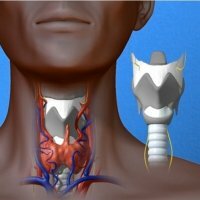Malignant neoplasm of larynx

The larynx is an unpaired organ of the human body and has a rather complex structure. In the larynx there is a crosshair of the digestive and respiratory tract. The larynx has several functions: voice-forming, respiratory and protective. Various types of malignant tumors develop in the larynx. In 0.5-2.2% of cases, sarcomas are observed, even more rarely can be observed the development of other forms of malignant tumors, in the overwhelming majority of the larynx, squamous cell carcinoma develops( in 98 cases out of 100).
Clinical picture
Symptomatic of cancers in the larynx depends on the shape of the tumor, its growth, as well as the location of the localization. If the tumor is formed in the area of the lining, the person begins to feel pain when swallowed, which is irradiated to the ear on the affected side. As the tumor grows, a person begins to feel the feeling that there is a foreign body in the body. Painful sensations lead to the fact that a person begins to eat less often, as a result, this person can bring himself to exhaustion. In addition to the formation of a tumor, inflammation and destruction of the tissues that surround the formation occurs, which leads to the ingress of water and food into the trachea. If the tumor on the wall of the larynx significantly increases in size, then there is stenosis of the larynx, that is, constriction. With the germination of the vocal cords, hoarseness appears, and later complete aphonia may develop. If the tumor mass fills the laryngeal lumen, then the person is hampered by the respiratory capacity. The disintegration of education leads to hemoptysis and putrid smell from the mouth.
Metastases with this disease appear very quickly. In twenty-five cases, out of a hundred, two or even three sections of the larynx are affected when you see a doctor.
Cancer of the lining department develops, as a rule, endophytically. In this case, the vocal cords are affected, the laryngeal lumen narrows, and the trachea is often amazed.
Diagnosis of
Symptoms of a malignant tumor of the larynx appear quite early, but often patients are diagnosed incorrectly. Very often such patients receive treatment for laryngitis. In this regard, the diagnosis of "cancer" they put very late.
The diagnosis is based on anamnesis, x-ray studies, patient examinations with the help of fibrolaringoscopy and laryngoscopy. Computer tomography allows you to determine the extent of the spread of the tumor process. A biopsy is also done to confirm the diagnosis.
Treatment of
There are two methods of treatment - radiation therapy and surgery.
The use of radiotherapy is contraindicated if the diagnosis is the perichondritis of the cartilage of the larynx, the tumor affected the blood vessels and esophagus, regional and distant metastases have developed, and the patient's condition as a whole is very difficult.
In the third and fourth stages, preliminary radiation therapy is performed, while the entire neck is irradiated. Three or four weeks later they perform a radical operation. It can be an extended laryngectomy, a laryngectomy, a larynx resection. During the operation, regional metastases are removed.
Surgical treatment is used if the disease is in the first or second stages. However, as a rule, such treatment occurs in conjunction with radiotherapy, which allows a significant reduction in the size of the tumor. When irradiated, not only the treatment of the tumor nucleus, but also metastasis. In some cases, several irradiation sessions are carried out.
If a person is diagnosed with cancer of the lining of the larynx( except for his slightly differentiated species), then irradiation is ineffective, so in this situation, a surgical operation is performed.
In the treatment of cancer of the larynx, chemotherapy is also ineffective, and therefore as an independent type of treatment is not applied.
Forecast
Combined therapy for cancer in the first and second stage live at least five years, 75-90% of patients. At stage 3, the survival rate is 63-67%.
After therapy, post-operative rehabilitation is very important. During this period, patients need to teach speech.



